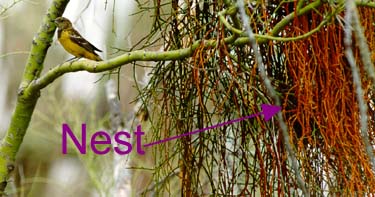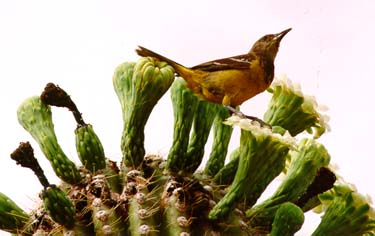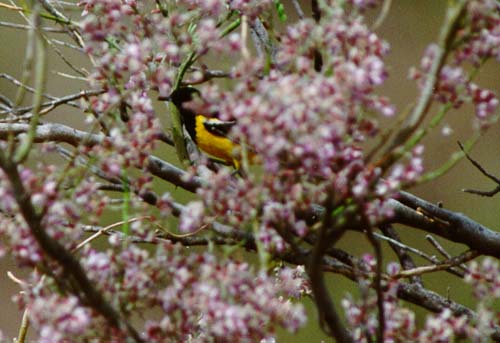Scott's Oriole With Nest Photo and Sound Recording, South-Central Arizona
Photos by Greg Clark, May 30, 1999
 The Scott's Oriole is adapted to many different habitats. In the dry wash habitat of the sonora desert this bird builds a nest in mistletoe (a parasite growing in some other tree). In the photo on the left you can see the female Scott's Oriole next to a clump of mistletoe hanging from a palo verde. (Palo Verde has branches that serve some of the functions as leaves, note the green color of the branch). Inside the mistletoe the nest can barely be seen. There are often references to Phainopepla nesting in mistletoe. Although this is true, Phainopepla do nest in mistletoe in a very similar way, one is just as likely to find a Phainopepla nest that is not in mistletoe. The bird that is strongly associated with mistletoe (in the sonoran desert) is the Scott's Oriole. Because the female will flush from the nest as one walks by, it is possible to find a nest in this way. Otherwise, they are extremely hard to spot, especially if there are many trees with mistletoe. The male does sing in the vicinity of the nest (as does the female) but the vicinity may be several hundred feet in all directions.
The Scott's Oriole is adapted to many different habitats. In the dry wash habitat of the sonora desert this bird builds a nest in mistletoe (a parasite growing in some other tree). In the photo on the left you can see the female Scott's Oriole next to a clump of mistletoe hanging from a palo verde. (Palo Verde has branches that serve some of the functions as leaves, note the green color of the branch). Inside the mistletoe the nest can barely be seen. There are often references to Phainopepla nesting in mistletoe. Although this is true, Phainopepla do nest in mistletoe in a very similar way, one is just as likely to find a Phainopepla nest that is not in mistletoe. The bird that is strongly associated with mistletoe (in the sonoran desert) is the Scott's Oriole. Because the female will flush from the nest as one walks by, it is possible to find a nest in this way. Otherwise, they are extremely hard to spot, especially if there are many trees with mistletoe. The male does sing in the vicinity of the nest (as does the female) but the vicinity may be several hundred feet in all directions.
 The same female oriole investigating saguaro cactus blossoms for food.
The same female oriole investigating saguaro cactus blossoms for food.
 The male Scott's Oriole hiding in a blooming ironwood tree
The male Scott's Oriole hiding in a blooming ironwood tree
About the recording:
On the recording a small amount of both male and female calls, near the nest, can be heard. The male and female call and answer. The majority of the recording is the male singing near the nest.
The original Scott's Oriole sound recording was made on May 30, 1999 in south-central Arizona. The recording was produced using a Sennheiser MKH70 shotgun microphone and the audio was stored on a 48 ksps DAT using a Tascam DA-P1 digital audio recorder. The recording was down-sampled to 44.1 ksps and converted to MPEG3 to reduce the file size.
download mpeg3 recording (scottor.mp3)
download mpeg3 decoder
mirror-pole.com home
Copyright Greg Clark, 1999
 The Scott's Oriole is adapted to many different habitats. In the dry wash habitat of the sonora desert this bird builds a nest in mistletoe (a parasite growing in some other tree). In the photo on the left you can see the female Scott's Oriole next to a clump of mistletoe hanging from a palo verde. (Palo Verde has branches that serve some of the functions as leaves, note the green color of the branch). Inside the mistletoe the nest can barely be seen. There are often references to Phainopepla nesting in mistletoe. Although this is true, Phainopepla do nest in mistletoe in a very similar way, one is just as likely to find a Phainopepla nest that is not in mistletoe. The bird that is strongly associated with mistletoe (in the sonoran desert) is the Scott's Oriole. Because the female will flush from the nest as one walks by, it is possible to find a nest in this way. Otherwise, they are extremely hard to spot, especially if there are many trees with mistletoe. The male does sing in the vicinity of the nest (as does the female) but the vicinity may be several hundred feet in all directions.
The Scott's Oriole is adapted to many different habitats. In the dry wash habitat of the sonora desert this bird builds a nest in mistletoe (a parasite growing in some other tree). In the photo on the left you can see the female Scott's Oriole next to a clump of mistletoe hanging from a palo verde. (Palo Verde has branches that serve some of the functions as leaves, note the green color of the branch). Inside the mistletoe the nest can barely be seen. There are often references to Phainopepla nesting in mistletoe. Although this is true, Phainopepla do nest in mistletoe in a very similar way, one is just as likely to find a Phainopepla nest that is not in mistletoe. The bird that is strongly associated with mistletoe (in the sonoran desert) is the Scott's Oriole. Because the female will flush from the nest as one walks by, it is possible to find a nest in this way. Otherwise, they are extremely hard to spot, especially if there are many trees with mistletoe. The male does sing in the vicinity of the nest (as does the female) but the vicinity may be several hundred feet in all directions. The same female oriole investigating saguaro cactus blossoms for food.
The same female oriole investigating saguaro cactus blossoms for food. The male Scott's Oriole hiding in a blooming ironwood tree
The male Scott's Oriole hiding in a blooming ironwood tree